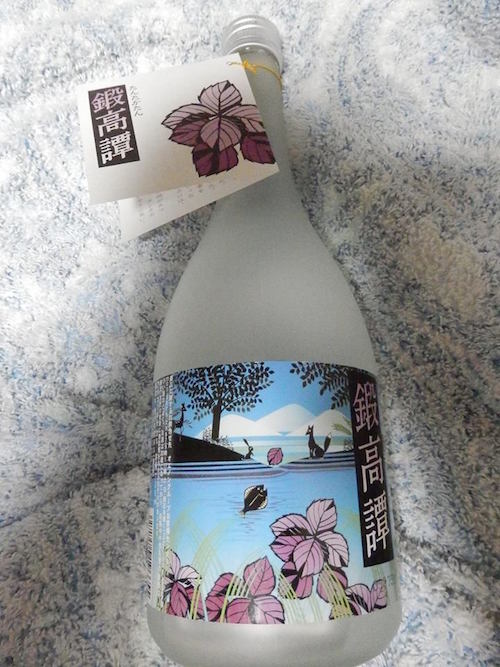189. The "High" Radical: 高
With the 高 radical, we enter the high life.
The "high" radical looks identical to the only Joyo kanji in which it is on duty:
高 (119: high; amount)
Just as 高 can carry the kun-yomi たか•い (one of its five Joyo readings!), the Japanese call this radical たかい. In English, "high" or "tall" will work.
The 高 shape serves as a mere component in just one other Joyo kanji:
稿 (1266: manuscript; draft)

Photo Credit: Corey Linstrom
This bottle contains 鍛高譚 (たんたかたん), a type of shochu (a popular distilled Japanese liquor similar to vodka) blended with shiso leaves. That concoction must certainly tempt some people, but for me the most compelling part (other than the lovely label) is the palindrome of a name, as well as the hypnotic rhythm of the repeated た sounds.
The brewery website explains the origin of the product name, which combines 鍛 (forging), 高, and the non-Joyo 譚 (story). The first part, 鍛高 (タンタカ), is an Ainu word for "flatfish," so 鍛高譚 means "story of a flatfish."
The protagonist of that tale is Tantaka, a flatfish who lives off the Hokkaido coast. One day the ocean water becomes muddy there, and his friends panic, though Tantaka himself is still safe, as he lives in deeper water. Nevertheless, he seeks to purify the water and learns from an old turtle that one plant with purple leaves will do the trick. Tantaka swims upstream to a mountain and enlists the aid of nearby animals to collect the leaves, which he brings back to the sea, successfully cleaning the water. The mountain then comes to be called 鍛高山 (たんたかやま). And the purple leaves turn out to be shiso.
The liquor label shows Tantaka in the center, the shiso leaves, and the animals who gathered them.
Watchtower on a Hill
Henshall says in his newer edition that early forms of 高 feature a structure, possibly a watchtower, on a hill or mound. He cites one etymology expert who interprets the lower 口 as representing a "hollowed-out room in the hill or mound." A second specialist sees that square as an "entrance." And a third man perceives it as a "receptacle for prayers or incantations."
The Parent and the Variant
Whereas the 高 shape consists of 10 strokes, the variant 髙 contains 11. I see no examples of 髙 tucked inside non-Joyo kanji, which is often where radical variants lurk. But to my great surprise I found this variant form in loads of signs—for a cafe, for music classes, for Citibank, for cow milk ... I can detect no pattern whatsoever here! Check out these two photos:
Photo Credit: Eve Kushner
The sign for a Kobe store called 本高砂屋 (ほんたかさごや) features the variant of 高. The 屋 also looks strange, sporting an extra 厂 for no apparent reason. I thought all of 砂 looked funny, but my proofreader shrugged it off, saying only that the 少 component is somewhere between the cursive and semicursive scripts for that character.
The さご yomi of 砂 puzzled me, too. I've since learned that the archaic term いさご meant "sand" and that 高砂 (たかさご) represents several things, including "sandhill," "the name of a place in Hyogo Prefecture (on Honshu)," and "Taiwan." In fact, when the Japanese ruled that island, they referred to the aboriginal tribes there as 高砂族 (たかさごぞく).
Photo Credit: Eve Kushner
In a different sign the same store went all out, now embellishing the bottom of the 高, too. The other words are as follows:
元祖 (がんそ: true, original)
神戸 (こうべ: Kobe)
銘物 (めいぶつ: special product, specialty), a coinage
きんつば (confection of sweetened beans wrapped in wheat-flour dough)
